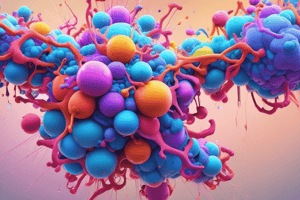Podcast
Questions and Answers
What primary role do rods and cones play in the visual system?
What primary role do rods and cones play in the visual system?
- Cone cells are responsible for night vision.
- Rod cells are primarily responsible for color vision.
- Cone cells operate best in low-light conditions.
- Rod cells are sensitive to light but do not detect color. (correct)
Which structure in the eye primarily accounts for the focusing of light?
Which structure in the eye primarily accounts for the focusing of light?
- Lens
- Cornea (correct)
- Retina
- Iris
How does the accommodation process assist in focusing images?
How does the accommodation process assist in focusing images?
- By thickening the lens through ciliary muscle contraction. (correct)
- By flattening the cornea.
- By lengthening the optic nerve.
- By spreading light rays thinly.
What is the transient phenomenon that occurs in the blind spot?
What is the transient phenomenon that occurs in the blind spot?
Which of the following statements about photoreceptors is accurate?
Which of the following statements about photoreceptors is accurate?
In terms of light sensitivity, how do rods and cones differ?
In terms of light sensitivity, how do rods and cones differ?
What describes the direction of neural impulse generation after light is transduced at photoreceptors?
What describes the direction of neural impulse generation after light is transduced at photoreceptors?
Which receptor type is primarily responsible for color vision?
Which receptor type is primarily responsible for color vision?
Which wavelength range constitutes the visible light spectrum for humans?
Which wavelength range constitutes the visible light spectrum for humans?
What phenomenon allows one eye to cover the blind spot of the other eye?
What phenomenon allows one eye to cover the blind spot of the other eye?
Flashcards are hidden until you start studying
Study Notes
Visual Transduction Overview
- Photopigments are found in the outer segment membranes of rods and cones, consisting of opsin (protein) and retinal (derivative of vitamin A).
- In darkness, open NA+/CA++ channels lead to glutamate release, causing membrane depolarization with open K+ channels contributing to this net effect.
- Light Activation Process:
- Light converts opsin and retinal, activating the G protein transducin.
- This subsequently activates phosphodiesterase, decreasing cGMP levels.
- Closure of NA+/CA++ channels occurs while K+ channels remain open, resulting in hyperpolarization of the retinal.
Phototransduction in Rod Photoreceptors
- Rhodopsin, formed by retinal and opsin, is pivotal for light absorption.
- A single rhodopsin molecule can activate substantial amplification responses:
- Absorbing one photon activates 500 transducin molecules.
- This leads to activation of 500 phosphodiesterase, hydrolyzing 10^5 cGMP molecules and closing 250 cation channels.
- Prevents entry of 10^6 to 10^7 Na+ ions per second.
Mechanisms of Receptor Regulation
- Agonist binding initiates the activation of G-proteins, leading to:
- Phosphorylation which promotes arrestin binding.
- Clathrin-coated pits facilitate clustering and endocytosis.
- Dissociation of agonist enables dephosphorylation and sorting between recycling and lysosomal pathways.
Light Transduction Comparison
- In dark conditions, trans-retinal binds with opsin to form rhodopsin, activating guanylate cyclase (GC) to increase cGMP, thus opening Na+ channels and depolarizing rod cells.
- In light, cis-retinal transforms to trans-retinal, dissociating from opsin, activating transducin, activating phosphodiesterase (PDE) which lowers cGMP, closing Na+ channels, and hyperpolarizing rod cells, reducing glutamate release.
Rhodopsin Cascade
- A powerful signal: one photon can block entry of one million Na+ ions due to the amplification processes.
Visual Stimulus and Eye Structure
- Electromagnetic Spectrum: Wavelengths range from 400 to 700 nanometers for visible light.
- Cornea contributes 80% to focusing; the lens provides the remaining 20% via adjustments for distance through ciliary muscle contraction.
- Blind Spot: Area where the optic nerve exits the eye, lacking receptors. The brain compensates by filling in this gap, often unnoticed due to overlap from the other eye.
Studying That Suits You
Use AI to generate personalized quizzes and flashcards to suit your learning preferences.




